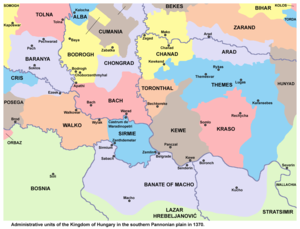Temes County
This article needs additional citations for verification. (December 2009) |
| Temes County Comitatus Temesiensis Temes vármegye Komitat Temes Comitatul Timiș Тамишка жупанија Tamiška županija | |
|---|---|
| County of the Kingdom of Hungary, Austria-Hungary | |
| 11th century–16th century 18th century-1920 | |
 | |
| Capital | Temesvár |
| Area | |
• 1910 | 7,433 km2 (2,870 sq mi) |
| Population | |
• 1910 | 500,835 |
| History | |
• Established | 11th century |
• Treaty of Trianon | 4 June 1920 16th century 18th century-1920 |
| Today part of | |
| Timișoara is the current name of the capital. | |

County of Temes (Hungarian: Temes, Romanian: Timiș, Serbian: Тамиш or Tamiš, German: Temes or Temesch) was an administrative county (comitatus) of the Kingdom of Hungary, Austria-Hungary. Its territory is now in southwestern Romania and northeastern Serbia. The capital of the county was Temesvár (Romanian: Timișoara, Serbian: Темишвар or Temišvar, German: Temeswar or Temeschwar).
Geography
Temes county was located in the Banat region. It shared borders with the Kingdom of Serbia and the Hungarian counties of Torontál, Arad and Krassó-Szörény. The river Danube formed its southern border, and the river Maros its northern border. The river Temes flowed through the county. Its area in 1910 was 7,433 km².
History
Temes County was formed in the 11th century, after the establishment of Hungarian rule in the region. It was named after the local Temes river. Principal center of the County was named Temesvár in Hungarian language, meaning literally: Temes Castle. The area was taken by the Ottoman Empire in the middle of 16th century and the county was abolished. This territory was then included into the Ottoman Temeşvar Eyalet.
After the region was captured by the Habsburgs in 1716, the area was included into the so-called Banat of Temeswar, a Habsburg province with administrative center in Temeswar. This province was abolished in 1778, and the county of Temes was restored. It was incorporated into Habsburg Kingdom of Hungary.
Between 1849 and 1860, the area of the county was part of Voivodeship of Serbia and Temes Banat, a separate Austrian crown land. During this time, the county did not existed since voivodeship was divided into districts. Temes County was re-established after 1860, when the area was again incorporated into the Habsburg Kingdom of Hungary.
In 1918, the county first became part of the newly proclaimed Banat Republic that lasted only few days. The region was taken by Serbian and French troops, and then divided in 1919 between Romania and the also newly formed Kingdom of Serbs, Croats and Slovenes, which was confirmed at the Paris Peace Conference. A majority of the county was assigned to Romania, while the south-western third was assigned to the Kingdom of Serbs, Croats and Slovenes (renamed to Yugoslavia in 1929).
The Yugoslav part of the pre-1918 Temes County (the southern Banat region) is part of the Serbian autonomous region of Vojvodina. The Romanian part is now part of Timiș County, except a 10 km wide strip along the Mureș River, which is in the Romanian Arad County.
Demographics
1900
In 1900, the county had a population of 476,242 people and was composed of the following linguistic communities:[1]
Total:
- German: 171,087 (35,9%)
- Romanian: 167,523 (35,2%)
- Serbian: 64,902 (13,6%)
- Hungarian: 58,153 (12,2%)
- Slovak: 2,977 (0,6%)
- Croatian: 387 (0,1%)
- Ruthenian: 79 (0,0%)
- Other or unknown: 11,134 (2,4%)
According to the census of 1900, the county was composed of the following religious communities:[2]
Total:
- Eastern Orthodox: 223,247 (46,9%)
- Roman Catholic: 209,690 (44,0%)
- Greek Catholic: 12,360 (2,6%)
- Lutheran: 11,993 (2,5%)
- Jewish: 9,745 (2,1%)
- Calvinist: 8,712 (1,8%)
- Unitarian: 111 (0,0%)
- Other or unknown: 384 (0,0%)
1910

In 1910, the county had a population of 500,835 people and was composed of the following linguistic communities:[3]
Total:
- Romanian: 169,030 (33,8%)
- German: 165,883 (33,1%)
- Hungarian: 79,960 (16,0%)
- Serbian: 69,905 (14,0%)
- Slovak: 3,080 (0,6%)
- Croatian: 350 (0,0%)
- Ruthenian: 30 (0,0%)
- Other or unknown: 12,597 (2,5%)
According to the census of 1910, the county was composed of the following religious communities:[4]
Total:
- Eastern Orthodox: 232,057 (46,3%)
- Roman Catholic: 221,175 (44,2%)
- Lutheran: 13,611 (2,7%)
- Greek Catholic: 12,381 (2,5%)
- Calvinist: 11,135 (2,2%)
- Jewish: 9,734 (1,9%)
- Unitarian: 160 (0,0%)
- Other or unknown: 582 (0,1%)
Subdivisions

In the early 20th century, the subdivisions of Temes county were:
| Districts (járás) | |
|---|---|
| District | Capital |
| Buziasfürdő | Buziasfürdő (Romanian: Buziaş) |
| Csák | Csák (Romanian: Ciacova) |
| Detta | Detta (Romanian: Deta) |
| Fehértemplom | Fehértemplom (Serbian: Bela Crkva) |
| Kevevára | Kevevára (Serbian: Kovin) |
| Központ | Temesvár (Romanian: Timişoara) |
| Lippa | Lippa (Romanian: Lipova) |
| Temesrékas | Temesrékas (Romanian: Recaș) |
| Újarad | Újarad (Romanian: Aradu Nou) |
| Versec | Versec (Serbian: Vršac) |
| Vinga | Vinga (Romanian: Vinga) |
| Urban counties (törvényhatósági jogú város) | |
| Temesvár (Romanian: Timişoara) | |
| Versec (Serbian: Vršac) | |
| Urban districts (rendezett tanácsú város) | |
| Fehértemplom (Serbian: Bela Crkva) | |
The towns of Vršac, Bela Crkva, and Kovin are now in Serbia; the other towns mentioned are now in Romania.
References
- ^ "KlimoTheca :: Könyvtár". Kt.lib.pte.hu. Retrieved 2012-06-26.
- ^ "KlimoTheca :: Könyvtár". Kt.lib.pte.hu. Retrieved 2012-06-26.
- ^ "KlimoTheca :: Könyvtár". Kt.lib.pte.hu. Retrieved 2012-06-26.
- ^ "KlimoTheca :: Könyvtár". Kt.lib.pte.hu. Retrieved 2012-06-26.
- States and territories established in the 11th century
- 16th-century disestablishments
- States and territories disestablished in 1918
- Counties in the Kingdom of Hungary
- Medieval history of Vojvodina
- Vojvodina under Habsburg rule
- Serbia under Habsburg rule
- History of Banat
- Transylvania in the Kingdom of Hungary
- States and territories established in the 18th century
- 11th-century establishments in Europe


